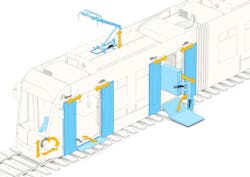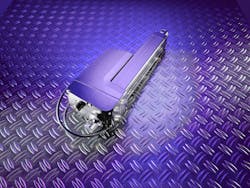Actuators are on Track for the Electrified Public Transit Boom
Transit system designers have increasing needs for longer life and higher durability on components, particularly the actuators that enable safe, flexible connections to power sources. Fortunately, a new line of electric linear actuators is now available to meet this need.
The Role of Actuators in Electrified Vehicles
Actuators enable electric trams, buses, and trains to connect and disconnect with power sources intermittently. This frequent connection and disconnection is not as necessary in most conventional applications because they rely on a single power source to which they connect once in the morning and stay connected until the end of their day. Hybrid vehicles, on the other hand, use battery power for routes that extend beyond city limits but switch back to cleaner and more economical overhead power many times as they run their routes. This approach to charging the battery will become increasingly important as the number of electric trams, buses, and trains increases.
Actuators manage the overhead switching by controlling spring-loaded pantographs—mechanical assemblies that sit on top of a vehicle and elevate above to connect with overhead power lines. (Figure 1) A spring raises the pantograph to connect and maintain contact with the overhead power line, and the actuator pulls the pantograph away from the power source when switching to battery power. In other designs, the actuator may pre-load the spring that raises the pantograph to the overhead power line. More efficient intermittent switching reduces the need to add aesthetically challenging and potentially dangerous overhead wiring within city limits as mass transit use increases.
Some designs use pneumatic actuators to manage pantograph connectivity, but the related air compression gives off moisture that can cause clogging and, in low temperatures, icing. Pneumatic solutions also need many more components, including pumps, pipes, and compressed air systems. The increase in ridership compounds such issues, making pneumatic solutions increasingly less attractive as traffic increases.
Actuators also guide the switching to recharging stations, helping hybrid buses get the power they need to operate during the day. And for trains that get power from third rails, actuators control the extension of the contacts from the train to the powered rail.
Where existing applications might be demanding actuators with lifetimes between 20,000 and 30,000 cycles, daily cycle increases resulting from increased ridership are expected to require actuators with lifetimes in the 500,000 to 1,000,000 cycle range.
Rising to the Occasion
Surviving such a high volume of cycles requires changes to the ball screw kit, motor design, braking strategy, and environmental resistance.
Upgraded Ball Screw Kit
The actuator ball screw kit includes the ball screw, nut, and bearings. Achieving up to a million cycles of life requires modification of the kit. Thomson Industries, Inc., for example, has been able to increase cycle capacity more than tenfold by making three major design changes. The first change is utilizing a larger diameter ball screw, strengthening the system at its core. The second change is implementing a multi-start ball return on the nut, which enables twice the number of balls that form the connection between nut and screw, and spreads the load more broadly across the balls. And, deployment of angular bearings to the screw now provides greater stability and component stress reduction.
Brushless Motors
The motor design also impacts actuator life. Most actuators currently installed on electrified vehicles use traditional contact brush-based DC motors. But the brushes eventually wear out—much too soon for the extended use that the transit designers are projecting. Replacing the brushes with an electromagnetic field is a much better alternative. Without friction from contact brushes, the motor can last virtually forever. There will, of course, be some wear on bearings or other parts of the motor, but the system longevity no longer depends on brush life.
Electromagnetic Braking
Using a brushless motor also contributes to a longer life by enabling electromagnetic control. In a pantograph, the actuator works against a spring. In one direction, it is the opposing force; in the other direction, it is an assisting force. An opposing spring provides stable, more controlled speed in one direction. An assisting spring, on the other hand, allows a more free-wheeling operation that must be controlled. Typically, the speed is controlled with a friction brake when the spring is assisting. But with extended use, friction brakes wear down and limit the life of the actuator. A better braking approach is to control the speed with the brushless motor and use an electromechanical brake to hold the load in place once the actuator stops.
Heightened Environmental Resistance
Actuators used in public transit applications are already subject to government health and safety regulations, and expanded use will require maximum adherence. Where vehicles in less-frequent operation might be able to use a lower ingress protection level such as IP65 on current solutions, expanded operation of a train moving at more than 60 miles per hour would result in greater exposure to environmental forces and would likely require a higher protection level. Such factors are driving actuator suppliers to ensure that their materials and sealing strategies will protect for the 20 or 30 years that the vehicles themselves may last. Here are some of the environmental characteristics that are needed for maximum environmental resistance of high-volume transportation applications:
- IP69K (static), and IP66 (dynamic) ratings:
- IP-X6 (dynamic) during water splash at +10°C (+50°F) and an equalized actuator temperature of +85°C (+185°F)
- At least 500 hours of salt spray resistance
- Operation in a wide temperature range from -40 to +85°C (-40 to +185°F)
- 300 hours of resistance to solar radiation (UV), according to IEC 60068-2-5
Additionally, the railway industry has issued international safety standards and regulations for components and equipment used for critical operations (EN 50155, EN 60077, and EN 45545).
35 Percent Duty Cycle
When implemented together, the enhanced ball screw kit, brushless motor, electromagnetic braking, and environmental resistance can increase the duty cycle considerably. The Thomson Electrak LL actuator shown in Figure 2, for example, provides a duty cycle as high as 35%t compared to 20% for other electric linear actuators at the same operational temperature and load. High duty cycles enable more work to get done in a given timeframe without having to resort to forced cooling or using an actuator that is stronger than the load requires, just to avoid overheating.
What’s Coming Down the Road?
In today’s transportation applications, actuators primarily provide the switching function and will continue to do so. However, switching requires some onboard electronics, which enables actuators to communicate with each other and with other devices, providing operators with information such as feedback on the position of the pantograph.
Although actuators used for charging stations are among the first components that must be upgraded to accommodate increased ridership and expanded electrification, other suitable actuator applications may soon follow, including door operation, step leveling, rail car connecting, and gap control for safe and easy passenger access. Until now, these applications have primarily been managed by pneumatic or hydraulic actuators, but with increased cycles and the requirement for more efficient and robust components, engineers should consider the more aptly suited electric linear actuators for their designs.
For more information, visit https://www.thomsonlinear.com/en/products/linear-actuators/electrak-hd


